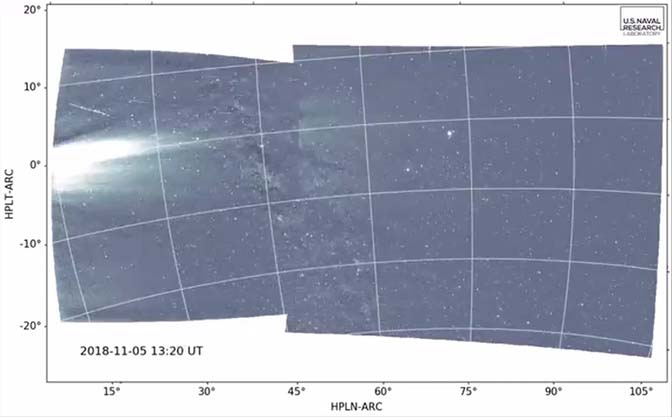
PHOTO CREDIT: NRL/NASA. Movie processed/compiled by Guillermo Stenborg and Brendan Gallagher (NRL).
NASA’s Parker Solar Probe (PSP) has flown closer to the Sun than any spacecraft before. Over 24 scheduled orbits, PSP will journey closer and closer to our star with the aim of flying as close as 8.86 R? from the solar surface by 2024. PSP, which launched on 2018 August 12, was designed, built, and now operated for NASA by the Johns Hopkins Applied Physics Laboratory. It has completed the first 3 of its 24 scheduled orbits about the Sun (perihelia on 2018 November 5, 2019 April 4, and 2019 September 1). All three orbits had roughly the same perihelion distance of 35.7 R? from the Sun center. On 2019 December 26, the spacecraft flew by Venus for the second time since launch. This maneuver reduced the perihelion to 27.8 R?, which was achieved on 2020 January 29.
The main science goal of the PSP mission is to determine the structure and dynamics of the Sun’s coronal magnetic field, to understand how the solar corona and wind are heated and accelerated, and to determine what processes accelerate energetic particles. PSP explores the near solar environment through in situ and remote sensing observations of the magnetic field, plasma, and energetic particles to: (i) trace the flow of energy that heats and accelerates the solar corona and solar wind, (ii) determine the structure and dynamics of the plasma and magnetic fields at the sources of the solar wind, and (iii) explore mechanisms that accelerate and transport energetic particles. Understanding the heating and acceleration of the solar wind plasma as well as the energization and transport of solar energetic particles has been sought for decades. By exploring the source regions of these fascinating phenomena, PSP will not only help us make major strides in our understanding but will also lead to unforeseen discoveries.
Over the past year and a half, PSP returned an enormous amount of science data that drew a new picture of the source region of the solar wind. The first discoveries of the mission were reported in the Nature magazine on 2019 December 4. This special issue of the Astrophysical Journal Supplement series consists of over 50 science papers that provide more detailed analyses of the data from the first two orbits. The number of discoveries is more than anyone has anticipated.
Read the article and watch the movie (00:14) online.
link submitted by Michael McIntyre
